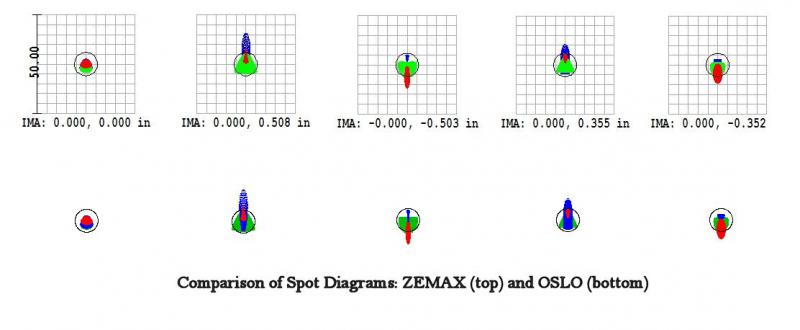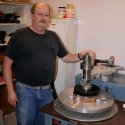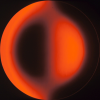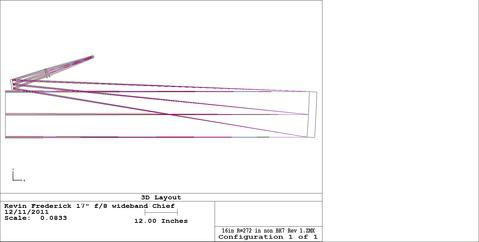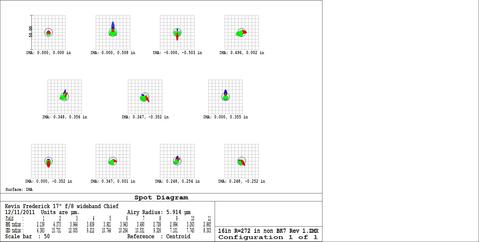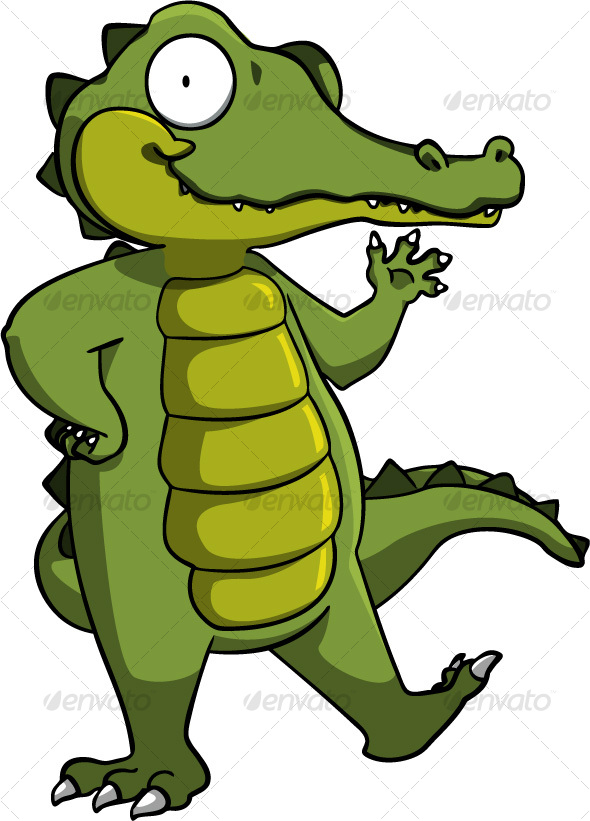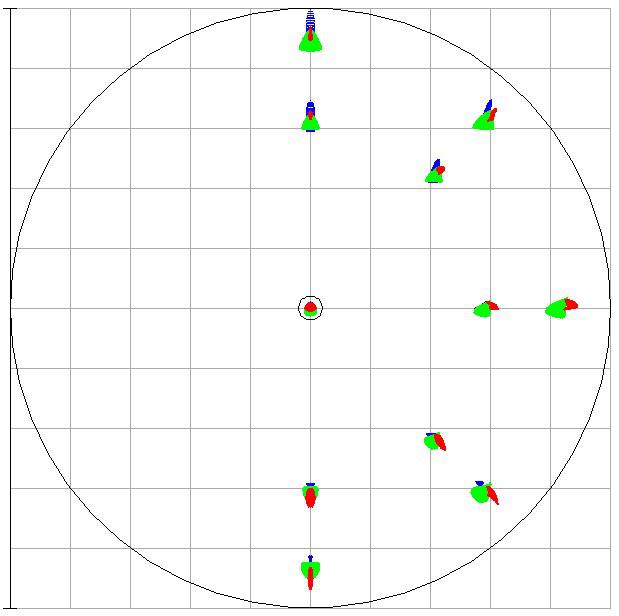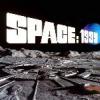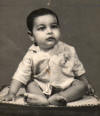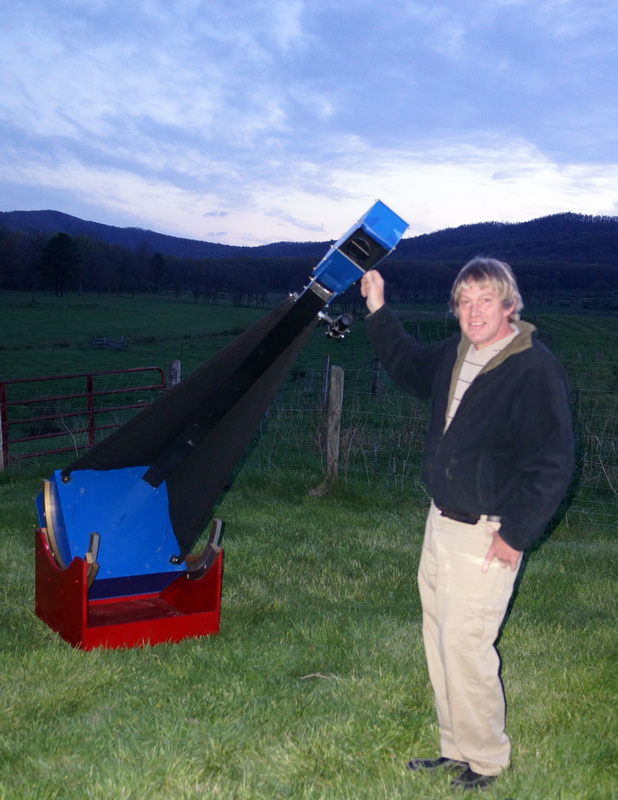
17 inch spotplots
#1

Posted 21 December 2011 - 09:25 AM
#2

Posted 21 December 2011 - 09:37 AM
#3

Posted 21 December 2011 - 10:38 AM
dan
#4

Posted 21 December 2011 - 11:34 AM
#5

Posted 21 December 2011 - 11:50 AM
#6

Posted 21 December 2011 - 03:49 PM
Mike
Attached Files
#7

Posted 21 December 2011 - 04:18 PM
And many many thanks to Kevin for keeping this ball rolling, people are simply not gonna believe what they're looking through - I think Mike said "17 inch apo!".
Best,
Mark
#10

Posted 21 December 2011 - 08:08 PM
How sensitive is it to exact spacing, and accuracy of the figure.... Some other OA designs go sideways quick with slight fabrication tolerances.
Mark
#11

Posted 21 December 2011 - 08:51 PM
We must pay homage to Cuzzin Ed Jones here, as my design is based on his innovative Chief design. I deviated from Ed's BK7 glass choice to bring indigo and blue light in better control, and the fold mirror is convex rather than flat, but basically it's still a Chief.
I will work on tolerancing Kevin's Chief over the Christmas break and post up the results.
Mike
#12

Posted 21 December 2011 - 08:57 PM
#13

Posted 22 December 2011 - 12:26 AM
Best,
Mark
#14

Posted 22 December 2011 - 06:18 AM
#15

Posted 22 December 2011 - 07:31 AM
Half inch off axis for a 136 inch fl is 0.2 degrees. The 1 -inch field is 0.4 degrees - less than the Moon, which is between 0.48 and 0.57 degrees.Thanks for posting. I hadn't realized just how good that design can be. How wide a field does the 0.5inch spot represent?
dan
Mladen
#16

Posted 22 December 2011 - 08:09 AM
#17

Posted 22 December 2011 - 10:06 AM
Mike
#18

Posted 22 December 2011 - 10:14 AM
Not surprisingly, tilt of the convex secondary is the most sensitive parameter. It will definitely need precision tilt adjustment, and that must stay fixed over the full range of telescope elevation angles.
Tolerances take a while to adjust and execute. I'll try to finish and post up tolerances over the Christmas/NY break. What I've seen so far tells me that for both elements, radii should be held to 0.1% either side of nominal, thicknesses should be within ±0.005", and element wedge should be less than 0.001".
Mike
#19

Posted 22 December 2011 - 11:30 AM
#20

Posted 22 December 2011 - 11:57 AM
I for one am a strong believer that more of these "fringe-ey" non-intuitive wack-job telescope optical configurations still exist. They are all about delicate balancing of oblique high-order monochromatic and polychromatic aberrations over a finite "sweet spot" of sufficient optical quality. So those of you with any decent optical design program, keep on looking and experimenting. I don't think we've found them all.
Mike
#21

Posted 22 December 2011 - 12:05 PM
Mike
#22

Posted 22 December 2011 - 01:09 PM
#23

Posted 22 December 2011 - 01:44 PM
What I've seen so far tells me that for both elements, radii should be held to 0.1% either side of nominal, thicknesses should be within ±0.005", and element wedge should be less than 0.001".
Is this absolute or can the spacings be adjusted to accommodate as-manuf actual specs? Both Kevin (I think) and myself are just planning to have these lenses made commercially.
My other question is (obviously) going to be about coatings - we've all seen the kind of charges for small qty coatings on lenses. With 4 surfaces what would any tradeoff look like?
Finally, since I'm already planning to manufacture large fast hyperboloids the quartz primary will be more like a vacation.
Best,
Mark
#24

Posted 22 December 2011 - 02:19 PM
Oh that goes without saying, Mike. Ed's configuration is awesome, even if the angular image field is somewhat restricted. It should be mentioned that its performance off axis is better than a classic paraboloid of the same aperture and focal length. Likewise, Ed's design is more compact than a classic Newtonian version.s Kevin will almost exclusively use this as a visual instrument, there wasn't a need to design for a field wider than 1" diameter. It could be done, but at the expense of sharpness over the central 1" format. I have experimented with wider FOV's using a third element, but so far I have encountered diminishing returns
The only thing I see as being somewhat more of a challenge is (1) the hyperboloidal primary, and (2) the fact that Ed's design is a compound system. As such it would have to be figured at the focus by autocollimation or interferometry. So, a lot more work than an ordinary Newotnian.
Mladen
#25

Posted 22 December 2011 - 06:22 PM



